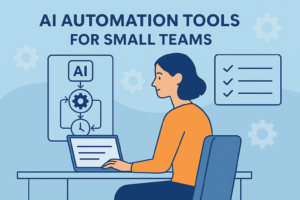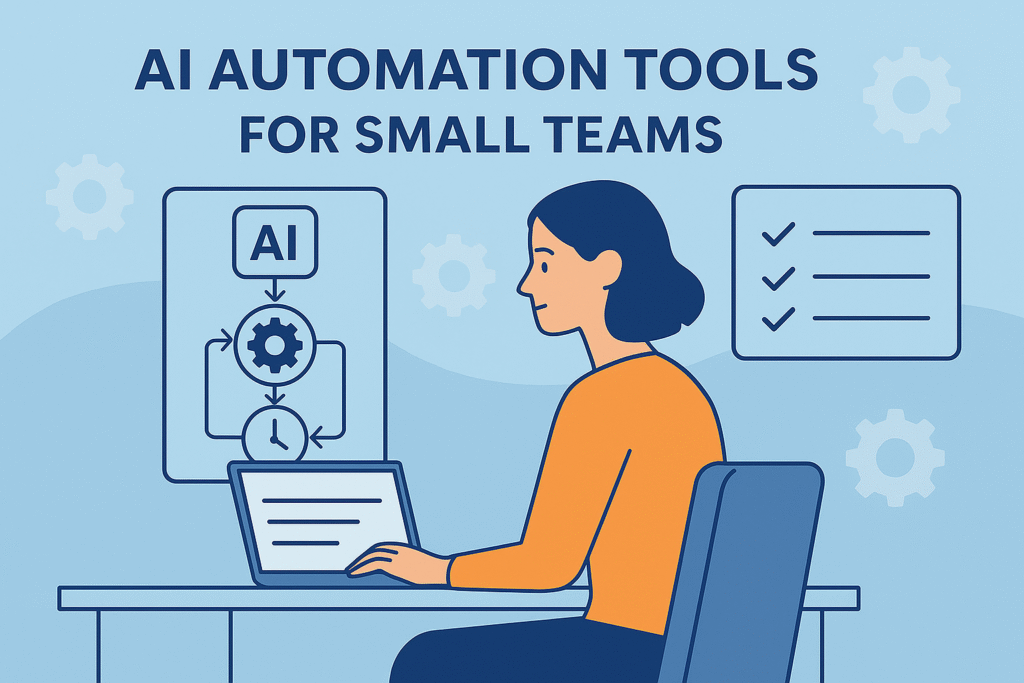Key Takeaways
- Choose tools that remove steps, not add dashboards. Simplicity scales faster than features.
- Automate routine decisions only. Keep human override for judgment calls and exceptions.
- Build from the middle out. Start with systems that touch multiple teams and integrate there first.
- Recommended toolkit highlights:
- Blaze Autopilot — backbone workflow automation. Learn more
- Notion AI — documentation and project thinking that scales.
- Make — deep workflow connector for complex logic without code.
- Jasper — quick, editable copy that respects your voice.
- Tability — ties tasks to measurable outcomes so work actually moves goals forward.
- Audit quarterly. Remove overlaps. Measure hours saved, not tasks run.
- If automation needs daily babysitting, it is not saving time. Simplify or delete.
If your team spends more time managing tools than using them, you’ve already lost.
Every small business in 2025 has the same problem: too many dashboards, too little clarity. The world screamed “AI will save you,” and now you’ve got five logins and zero free hours.
The truth is brutal most “AI automation tools for small business” don’t save time; they just shift your chaos to the cloud.
Small teams can’t afford digital drama. They need automation that stays quiet, keeps promises, and gives back hours instead of notifications.
This guide cuts through the hype.
No buzzwords. No miracle claims.
Just the tools that actually deliver more done with less noise.

Why Small Teams Need Ruthless Automation
Big brands automate for comfort.
Small teams automate to survive.
When every person plays three roles, automation becomes your invisible employee the one that never sleeps or “forgets to send the file.”
But here’s the catch: if your system is messy, automation multiplies the mess. That’s why small teams don’t need “more tools.” They need a system that replaces routine, not reasoning.
Ruthless automation starts with intent.
You automate to free thinkers, not replace them.
You build workflows that remove drag the tiny, constant frictions that steal your creative hours.
And once that system clicks, small teams start punching like giants.
What “AI Automation” Really Means in 2025
Everyone’s selling “AI-powered” something this year.
Half the time, it’s just a new button on an old interface.
In 2025, real AI automation tools for small business share three simple traits:
they think, learn, and adapt without turning your workflow into a maze.
Here’s what that actually means:
- Smart triggers
Actions happen when something real happens a sale, a signup, a file upload.
No more clicking “send” or “approve” like a human timestamp. - Learning loops
The system improves the more you use it.
If you fix the same issue twice, it learns to fix it before you notice the third. - Human override
Automation isn’t freedom if you can’t pull the plug.
Every great tool gives you a big red “stop” button and an even better undo.
If a product doesn’t do these three things, it’s not automation it’s decoration.
The smartest small teams don’t chase new features. They chase fewer steps.
Because in 2025, the real currency isn’t AI it’s focus.
The Tools That Actually Save Time (Part I)
Let’s stop talking theory and start talking tools.
Here’s what actually saves hours when your team’s small, lean, and allergic to waste.
1. Blaze Autopilot The Quiet Backbone
Some tools scream for attention. Blaze doesn’t.
It’s automation that works in silence quietly managing your recurring tasks, scheduling, and workflows while you get back to real work.
Plan once, automate the boring, review once a week.
That’s the entire religion behind Blaze.
It’s the difference between “Did you send that?” and “Already done.”
The kind of calm efficiency that turns three-person teams into ten-person output.
The Other Top Tools That Earn Their Keep
2. Notion AI – The Thinking Workspace
Notion AI is what happens when notes start making sense on their own.
It turns scattered ideas into usable systems, from SOPs to weekly recaps.
Perfect for small teams that live in documents and drown in them too.
You ask, it writes. You summarize, it remembers.
Use it to generate meeting notes, content briefs, or task summaries that actually reflect what your team said, not what some template thinks you meant.
The trick is to guide it like a human intern.
Ask it why, not just what, and you’ll see the difference between a paragraph generator and a thinking assistant.
3. Make (formerly Integromat) The Connector
Make is the bridge between your islands.
Where Zapier handles the surface, Make handles depth.
You can build logic-heavy automations that pass real data between tools without code.
It’s for teams that want control without hiring developers.
Drag, drop, test, repeat until your tools behave like one organism instead of six separate apps.
Pro tip: draw your workflow on paper before automating it.
Every failed automation starts with an unclear diagram.
4. Jasper — The Copy Catalyst
Jasper is the content engine small teams use when they don’t have time to sound smart but still need to sell.
It drafts product pages, blog intros, and email sequences fast enough to keep your pipeline full without losing your tone.
Feed it your brand voice once, and it learns your rhythm.
But it’s not a replacement for judgment.
Always edit. Always inject human logic where AI guesses.
That’s how you keep the “AI voice” from sounding like a motivational poster.
5. Tability — The Goal Translator
If you can’t see your goals, your team won’t hit them.
Tability turns OKRs and KPIs into visual progress dashboards that update automatically.
It connects tasks to outcomes so no one forgets why they started a project in the first place.
It’s not flashy. It’s grounding.
And that’s what small teams need most — tools that turn chaos into rhythm.
The Real Cost of Bad Automation
Automation should feel invisible.
If you have to manage your automation daily, it’s not saving you time.
The hidden cost of most tools is maintenance.
Every new app adds friction: more logins, more notifications, more ways to break.
Before you know it, your “productivity stack” looks like a junk drawer.
Small teams can’t afford that.
They win by auditing, not adding.
Delete what overlaps. Simplify what repeats.
Because automation isn’t about speed — it’s about clarity.
The rule is simple:
If it doesn’t reduce mental load, it doesn’t belong.
The best automation stacks are quiet, predictable, and boring.
That’s the beauty of them. They disappear into the background while your team gets louder in the market.
How to Build an Automation Stack That Doesn’t Eat You Alive
The biggest trap small teams fall into is stacking tools before fixing systems.
Automation is not magic. It’s magnification.
If your process is messy, automation just multiplies the mess.
Start small. Build out from the middle.
Here’s the framework that actually works:
-
Map your real process
Write down every recurring task from lead to delivery. Highlight what repeats without judgment. -
Cut before you connect
Remove the tools you barely use. If a feature sits untouched for 30 days, it’s dead weight. -
Automate the middle, not the edges
The best ROI comes from workflows that touch multiple departments, like sending client updates or syncing content calendars. -
Test everything manually first
Run the process by hand before you automate it. If it fails manually, it’ll fail twice as fast automatically. -
Measure by time saved, not tasks completed
You’re not trying to look busy. You’re buying back hours.
When done right, automation turns into rhythm.
You stop asking if something’s done because it already is.
That’s when you know your system works for you, not the other way around.
2025 and Beyond-The Return of Focus
The AI arms race is over. The attention race has begun.
Every new tool promises productivity. Few deliver peace.
The winners in 2025 are not the ones with the biggest tech stacks.
They’re the ones who know when to stop adding.
Focus is the new edge.
Simplicity is the new scale.
The teams that will dominate this decade are the ones who use AI quietly — not as a badge, but as background.
Automation should feel like oxygen. You only notice it when it’s gone.
Because in the end, the goal isn’t to let machines work harder.
It’s to let humans think deeper.
Winding Up
Automation is not a trophy.
It is a tool that returns one thing you can never buy back: attention.
If a tool multiplies noise, delete it. If it buys you thinking time, keep it.
Small teams win by being choosy. Not by chasing every feature that flashes.
Build from the middle out. Measure real time saved. Review like an editor, not an engineer.
Do less that matters. Do it consistently. Keep the rest quiet.
That is the only strategy that scales.

